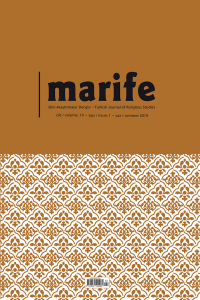
Marife Dini Araştırmalar Dergisi
Yazarlar: Ali ÇİFTCİ
Konular:Din Bilimi
Anahtar Kelimeler:The articulation-places of Arabic letters,The Tajwid,Tartil,Al-Dani,Tahdid,Madd,Waqf
Özet: The subject-matters written of the Science of Tajwid were first discussed by the Arabic linguists in the second century after Hijrah. Khalil bin Ahmad and his student, Sibawayh, wrote books on the nature of Arabic letters, their places of articulation, features, and the way they are connected to each other in speech. The literature on the Qira’ah whose composition preceded the composition of the books on the Tajwid also talked of the subjects of the Tajwid though briefly. Abu Muzahim al-Khaqani wrote his al-Qaṣidah al-Khaqaniyyah on the Tajwid in the fourth century after Hijrah which has been considered to be the earliest work on the Tajwid. The scholars who came after al-Khaqani composed works on the model of his. The fourth century after Hijraj is the period in which the Tajwid came to be dealt with as an independent Qur’anic discipline. Such scholars as Makki bin Ṭalib, Abu ‘Amer al-Dani, ‘Abdulwahhab bin Muhammad al-Qurtubi contributed independent and voluminous works to the Tajwid. This article is intended to discuss the subjects of the Tajwid by focusing on al-Tahdid fi al-Itqan wa al-Tajwid by al-Dani, trying to elaborate upon such styles of the recitations of the Qur’an as tahqiq, haḍr and tadwir with reference to the narrations. We shall also illustrate such terms of the Tajwid as harakah, sukun, rawm, ishmam, madd, idgham, ikhfa and ikhtilas. Al-Dani makes a systematic analysis of the articulation-places and features of the Arabic letters by availing himself of the works of the earlier linguists. Considering that the Tajwid can only be practiced through a proper training, al-Dani pointed out that the letters should be pronounced properly as combining the words, trying to illustrate this with Qur’anic chapters. Pointing to the necessity that the Qur’an should be grasped semantically in addition to its proper recitation, he also emphasized that one should avoid starting and stopping reading the verses in a way that would spoil the meaning. With this in mind, he tried to explain the requirements of the proper stopping during the recitation. Making a systematic analysis of the subject-matters of the Tajwid, al-Dani still keeps his position as an important authority for the following generations of the scholars on the Tajwid.